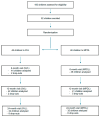Efficacy of Asymmetric Myopic Peripheral Defocus Lenses in Spanish Children: 24-Month Randomized Clinical Trial Results
- PMID: 40003293
- PMCID: PMC11854278
- DOI: 10.3390/children12020191
Efficacy of Asymmetric Myopic Peripheral Defocus Lenses in Spanish Children: 24-Month Randomized Clinical Trial Results
Abstract
Background/Objectives: Asymmetric myopic peripheral defocus lenses (MPDLs) have proven to be effective in slowing the progression of myopia in Spanish children over a period of 12 months. The purpose of this study was to assess the MPDL spectacles' efficacy in slowing myopia progression over a 24-month period in children. Methods: This study extends the follow-up period of the double-masked, prospective, and randomized clinical trial previously published to 24 months. Children from 6 to 12 years were assigned to two groups: a control group wearing spherotorical single vision lenses (SVLs) or a treatment group wearing MPDL lenses. Inclusion criteria included children with myopia less than -0.50 D, astigmatism below 1.50 D, and best-corrected visual acuity of at least 20/20. Participants underwent cycloplegic autorefractive examination and axial length (AL) measurements at the baseline and six and twelve months in the study already published, and twenty-four months later in the present study. Lifestyle factors, including outdoor activities and digital device use, were also assessed. Baseline characteristics, including age, refractive error, and AL, were comparable between groups. Dropout rates were 15.9%, with 14 participants lost to follow-up, distributed equally between the two groups. Results: After 24 months of follow-up, 69 children remained in this study, comprising 34 participants in the SVL cohort and 35 in the MPDL cohort. Over 24 months, the MPDL group showed significantly less AL elongation than the SVL group (0.27 ± 0.23 mm and 0.37 ± 0.24 mm; p = 0.0341). The mean relative AL increase was 1.10 ± 0.95% in the MPDL group, compared to 1.56 ± 1.02% in the SVL group (p = 0.0322). Younger children exhibited faster AL growth, while digital device use and outdoor activities did not affect AL changes. Conclusions: MPDL spectacle lenses substantially slowed myopia progression over a 24-month period, with 28.7% less progression in absolute AL growth and 29.8% in relative AL growth compared to SVL. These results indicate that MPDL lenses are an effective method for slowing myopia progression.
Keywords: axial length; myopia; spectacle lenses.
Conflict of interest statement
This research was funded by IOT. Authors M.Á., E.C. and J.M.C. were employed by IOT. The remaining authors confirm that no commercial or financial relationships influenced the conduct of this research.
Figures



Similar articles
-
Interventions to slow progression of myopia in children.Cochrane Database Syst Rev. 2020 Jan 13;1(1):CD004916. doi: 10.1002/14651858.CD004916.pub4. Cochrane Database Syst Rev. 2020. PMID: 31930781 Free PMC article.
-
Effectiveness of a Spectacle Lens with a Specific Asymmetric Myopic Peripheral Defocus: 12-Month Results in a Spanish Population.Children (Basel). 2024 Feb 1;11(2):177. doi: 10.3390/children11020177. Children (Basel). 2024. PMID: 38397289 Free PMC article.
-
Myopia Control Efficacy of Asymmetric Multipoint Defocus Technique Spectacle Lenses: One-Year Double-Masked Randomized Controlled Trial.Ophthalmology. 2025 Apr 28:S0161-6420(25)00272-6. doi: 10.1016/j.ophtha.2025.04.022. Online ahead of print. Ophthalmology. 2025. PMID: 40306584
-
Myopia Control Efficacy of Spectacle Lenses with Dual-Index Aspherical Lenslets: A 1-Year Randomized Clinical Trial.Ophthalmol Sci. 2025 Mar 14;5(4):100766. doi: 10.1016/j.xops.2025.100766. eCollection 2025 Jul-Aug. Ophthalmol Sci. 2025. PMID: 40385239 Free PMC article.
-
New Designs of Spectacle Lenses for the Control of Myopia Progression: A Scoping Review.J Clin Med. 2024 Feb 19;13(4):1157. doi: 10.3390/jcm13041157. J Clin Med. 2024. PMID: 38398469 Free PMC article.
References
LinkOut - more resources
Full Text Sources

